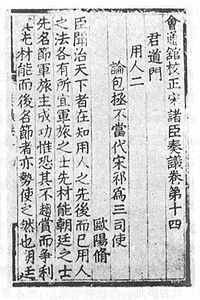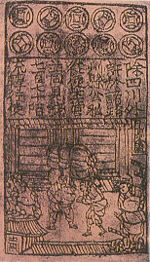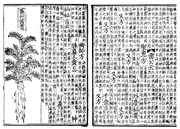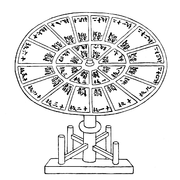
Hua Sui
Encyclopedia

China
Chinese civilization may refer to:* China for more general discussion of the country.* Chinese culture* Greater China, the transnational community of ethnic Chinese.* History of China* Sinosphere, the area historically affected by Chinese culture...
scholar and printer
Printer (publisher)
In publishing, printers are both companies providing printing services and individuals who directly operate printing presses. With the invention of the moveable type printing press by Johannes Gutenberg around 1450, printing—and printers—proliferated throughout Europe.Today, printers are found...
of Wuxi
Wuxi
Wuxi is an old city in Jiangsu province, People's Republic of China. Split in half by Lake Tai, Wuxi borders Changzhou to the west and Suzhou to the east. The northern half looks across to Taizhou across the Yangtze River, while the southern half also borders the province of Zhejiang to the south...
, Jiangsu
Jiangsu
' is a province of the People's Republic of China, located along the east coast of the country. The name comes from jiang, short for the city of Jiangning , and su, for the city of Suzhou. The abbreviation for this province is "苏" , the second character of its name...
province during the Ming Dynasty
Ming Dynasty
The Ming Dynasty, also Empire of the Great Ming, was the ruling dynasty of China from 1368 to 1644, following the collapse of the Mongol-led Yuan Dynasty. The Ming, "one of the greatest eras of orderly government and social stability in human history", was the last dynasty in China ruled by ethnic...
(1368-1644 AD). He belonged to the wealthy Hua family that was renowned throughout the region. Hua Sui is best known for creating China's first metal
Metal
A metal , is an element, compound, or alloy that is a good conductor of both electricity and heat. Metals are usually malleable and shiny, that is they reflect most of incident light...
movable type
Movable type
Movable type is the system of printing and typography that uses movable components to reproduce the elements of a document ....
printing
Printing
Printing is a process for reproducing text and image, typically with ink on paper using a printing press. It is often carried out as a large-scale industrial process, and is an essential part of publishing and transaction printing....
in 1490 AD. Metal movable type printing had been invented in Korea
Korea
Korea ) is an East Asian geographic region that is currently divided into two separate sovereign states — North Korea and South Korea. Located on the Korean Peninsula, Korea is bordered by the People's Republic of China to the northwest, Russia to the northeast, and is separated from Japan to the...
during the earlier 13th century, but there is no concrete evidence that suggests Hua Sui's metal type print was influenced by Korean printing.
Earlier wooden and ceramic types

Shen Kuo
Shen Kuo or Shen Gua , style name Cunzhong and pseudonym Mengqi Weng , was a polymathic Chinese scientist and statesman of the Song Dynasty...
(1031–1095) of the Song Dynasty
Song Dynasty
The Song Dynasty was a ruling dynasty in China between 960 and 1279; it succeeded the Five Dynasties and Ten Kingdoms Period, and was followed by the Yuan Dynasty. It was the first government in world history to issue banknotes or paper money, and the first Chinese government to establish a...
(960-1279 AD), the commoner and artisan Bi Sheng
Bi Sheng
Bì Shēng was the inventor of the first known movable type technology. Bi Sheng's system was made of Chinese porcelain and was invented between 1041 and 1048 in China.-Movable type printing:...
(990-1051) was the first to invent movable type, with his earthenware
Earthenware
Earthenware is a common ceramic material, which is used extensively for pottery tableware and decorative objects.-Types of earthenware:Although body formulations vary between countries and even between individual makers, a generic composition is 25% ball clay, 28% kaolin, 32% quartz, and 15%...
type invented in the Qing-li reign period (1041–1048). During the Yuan Dynasty
Yuan Dynasty
The Yuan Dynasty , or Great Yuan Empire was a ruling dynasty founded by the Mongol leader Kublai Khan, who ruled most of present-day China, all of modern Mongolia and its surrounding areas, lasting officially from 1271 to 1368. It is considered both as a division of the Mongol Empire and as an...
(1279-1368 AD), the governmental magistrate
Magistrate
A magistrate is an officer of the state; in modern usage the term usually refers to a judge or prosecutor. This was not always the case; in ancient Rome, a magistratus was one of the highest government officers and possessed both judicial and executive powers. Today, in common law systems, a...
and scholar Wang Zhen
Wang Zhen (official)
Wang Zhen was an official of the Yuan Dynasty of China. He is credited with the invention of the first wooden movable type printing in the world, while his predecessor of the Song Dynasty , Bi Sheng , invented the world's first earthenware movable type printing...
(fl.
Floruit
Floruit , abbreviated fl. , is a Latin verb meaning "flourished", denoting the period of time during which something was active...
1290-1333) invented wood
Wood
Wood is a hard, fibrous tissue found in many trees. It has been used for hundreds of thousands of years for both fuel and as a construction material. It is an organic material, a natural composite of cellulose fibers embedded in a matrix of lignin which resists compression...
en movable type
Movable type
Movable type is the system of printing and typography that uses movable components to reproduce the elements of a document ....
, as his process improved the speed of typesetting as well. Much like Bi Sheng experimenting with wooden movable type in the 11th century but finding it unsatisfactory, Wang Zhen also experimented with metal type printing using tin
Tin
Tin is a chemical element with the symbol Sn and atomic number 50. It is a main group metal in group 14 of the periodic table. Tin shows chemical similarity to both neighboring group 14 elements, germanium and lead and has two possible oxidation states, +2 and the slightly more stable +4...
. Wang Zhen wrote in the book of the Nong Shu (1313 AD):
In more recent times [late 13th century], type has also been made of tin by casting. It is strung on an iron wire, and thus made fast in the columns of the form, in order to print books with it. But none of this type took ink readily, and it made untidy printing in most cases. For that reason they were not used long.
Thus, Chinese metal type of the 13th century using tin was unsuccessful because it was incompatible with the ink
Ink
Ink is a liquid or paste that contains pigments and/or dyes and is used to color a surface to produce an image, text, or design. Ink is used for drawing and/or writing with a pen, brush, or quill...
ing process. Although unsuccessful in Wang Zhen's time, the bronze metal type of Hua Sui in the late 15th century would be used for centuries in China, up until the late 19th century. Furthermore, a font of tin movable type was successfully employed by a Mr. Tong of Guangdong
Guangdong
Guangdong is a province on the South China Sea coast of the People's Republic of China. The province was previously often written with the alternative English name Kwangtung Province...
in the 19th century, who figured out how to make it more compatible with the inking process.
Metal type of the Ming period

Taipei
Taipei City is the capital of the Republic of China and the central city of the largest metropolitan area of Taiwan. Situated at the northern tip of the island, Taipei is located on the Tamsui River, and is about 25 km southwest of Keelung, its port on the Pacific Ocean...
, Taiwan
Taiwan
Taiwan , also known, especially in the past, as Formosa , is the largest island of the same-named island group of East Asia in the western Pacific Ocean and located off the southeastern coast of mainland China. The island forms over 99% of the current territory of the Republic of China following...
), a simple collection of memorial
Memorial
A memorial is an object which serves as a focus for memory of something, usually a person or an event. Popular forms of memorials include landmark objects or art objects such as sculptures, statues or fountains, and even entire parks....
s printed in two editions. The books printed by Hua Sui contain the signature Hui Tong Guan (Studio of Mastery and Comprehension), meaning he had mastered the process of metal movable type printing. Including the Zhu Chen Zou Yi, published 15 titles using metal type, in a span of about 20 years.
Family relatives of Hua Sui caught on and engaged in metal type printing as well. Hua Cheng (1438-1514 AD), a distant relative of Sui, an antiquarian
Antiquarian
An antiquarian or antiquary is an aficionado or student of antiquities or things of the past. More specifically, the term is used for those who study history with particular attention to ancient objects of art or science, archaeological and historic sites, or historic archives and manuscripts...
, and book-collector, began his own printing studio known as Shang Gu Zhai (Studio for Esteeming Antiquities). He printed the Bai Chuan Xue Hai of 1501 using metal type, and printed many rare books he obtained in a rapid process thanks to the speed of metal typesetting. Hua Qian (fl. 1513-1516), a nephew of Hua Sui, was yet another bronze-type printer of the Hua family. His studio signature was Lan Xue Tang (Hall of Orchid and Snow), and his largest printing project was reprinting the old Tang Dynasty
Tang Dynasty
The Tang Dynasty was an imperial dynasty of China preceded by the Sui Dynasty and followed by the Five Dynasties and Ten Kingdoms Period. It was founded by the Li family, who seized power during the decline and collapse of the Sui Empire...
encyclopedia
Encyclopedia
An encyclopedia is a type of reference work, a compendium holding a summary of information from either all branches of knowledge or a particular branch of knowledge....
of the Yi Wen Lei Ju (1515). In addition, various members of the Hua family contributed to metal movable type printing, as about 24 book titles using metal type were published between 1490 and 1516.
There was another prestigious family of Wuxi, Jiangsu province, who engaged in metal type printing. This was the An family, most notably that of An Guo (1481–1534). However, the An family's printed works came shortly after the Hua family, the latter of whom were supposedly inspired by Shen Kuo's description of Bi Sheng's movable type in the Meng Xi Bi Tan (Dream Pool Essays
Dream Pool Essays
The Dream Pool Essays was an extensive book written by the polymath Chinese scientist and statesman Shen Kuo by 1088 AD, during the Song Dynasty of China...
) of 1088 AD. Yet the process of earthenware movable type and metal movable type are different, as metal movable type required many more complex technical processes of engraving, casting, type-setting, inking, and printing.

Changzhou
Changzhou is a prefecture-level city in southern Jiangsu province of the People's Republic of China. It was previously known as Yanling, Lanling, Jinling, and Wujin. Located on the southern bank of the Yangtze River, Changzhou borders the provincial capital of Nanjing to the west, Zhenjiang to the...
, Suzhou
Suzhou
Suzhou , previously transliterated as Su-chou, Suchow, and Soochow, is a major city located in the southeast of Jiangsu Province in Eastern China, located adjacent to Shanghai Municipality. The city is situated on the lower reaches of the Yangtze River and on the shores of Taihu Lake and is a part...
, and Nanjing
Nanjing
' is the capital of Jiangsu province in China and has a prominent place in Chinese history and culture, having been the capital of China on several occasions...
during the 16th century. Yet the sponsors of printing weren't all described as the works of simply the area's wealthiest local family, as the bronze-type books in Fujian
Fujian
' , formerly romanised as Fukien or Huguing or Foukien, is a province on the southeast coast of mainland China. Fujian is bordered by Zhejiang to the north, Jiangxi to the west, and Guangdong to the south. Taiwan lies to the east, across the Taiwan Strait...
province were developed by truly commercial enterprises. Chinese writing fonts of different sizes and scope could be jointly owned and invested in by more than one printer in the region.
In addition to bronze, there were also other metal types used for movable type printing. Lu Shen (1477-1544 AD) once reported in the early 16th century that printers of Changzhou used bronze and lead movable type printing, which could have been separate materials or an alloy
Alloy
An alloy is a mixture or metallic solid solution composed of two or more elements. Complete solid solution alloys give single solid phase microstructure, while partial solutions give two or more phases that may or may not be homogeneous in distribution, depending on thermal history...
mixture of the two.
The Qing period
During the Qing DynastyQing Dynasty
The Qing Dynasty was the last dynasty of China, ruling from 1644 to 1912 with a brief, abortive restoration in 1917. It was preceded by the Ming Dynasty and followed by the Republic of China....
(1644–1911), the imperial court had made wooden movable type the official printing method, overseen by the official Jin Jian (d. 1794) who had 253,000 wooden movable type font characters made in 1733. However, the Qing government also sponsored bronze-type printing, as they crafted 250,000 bronze characters earlier in 1725 to print the Gujin Tushu Jicheng
Gujin Túshu Jíchéng
The Gujin Tushu Jicheng , is a vast encyclopaedic work written in China during the reigns of Qing emperors Kangxi and Yongzheng, completed in 1725. The work was headed initially by scholar Chen Menglei , and later by Jiang Tingxi. It contained 800,000 pages and over 100 million Chinese characters...
(古今圖書集成, Complete Collection of Illustrations and Writings from the Earliest to Current Times). The encyclopedia encompassed 5020 volumes in length, as sixty six copies of the encyclopedia were made. Although the bronze characters were kept safe and deposited in the Wuying Palace, they were all melted down in 1744 in order to forge coin currency.
Beyond the imperial court, there were many small private industries and individual sponsors of printing during the Qing period. Chui-Li-Ge of Changshu
Changshu
Changshu is a county-level city under the jurisdiction of Suzhou, and is located in the south-eastern part of eastern-China’s Jiangsu Province as well as the Yangtze River Delta...
was known to have printed a large literary collection of his in 1686 AD. The Manchu military officer Wu-Long-A printed a collection of imperial edicts while stationed in Taiwan in the year 1807. The Chinese character font of some 400,000 bronze characters made by Lin Chun Qi took twenty one years to make, from 1825 until 1846. The total cost for the endeavor was 200,000 silver teals. These characters were used to print a variety of different books, including treatises on phonology
Phonology
Phonology is, broadly speaking, the subdiscipline of linguistics concerned with the sounds of language. That is, it is the systematic use of sound to encode meaning in any spoken human language, or the field of linguistics studying this use...
, medicine
Medicine
Medicine is the science and art of healing. It encompasses a variety of health care practices evolved to maintain and restore health by the prevention and treatment of illness....
, and military strategy
Military strategy
Military strategy is a set of ideas implemented by military organizations to pursue desired strategic goals. Derived from the Greek strategos, strategy when it appeared in use during the 18th century, was seen in its narrow sense as the "art of the general", 'the art of arrangement' of troops...
, and it is possible his same character font was used by the later Wu Chongjun of Hangzhou when he printed two other works in 1852.
Process and methods

Woodblock printing
Woodblock printing is a technique for printing text, images or patterns used widely throughout East Asia and originating in China in antiquity as a method of printing on textiles and later paper....
. Then there was the process of assembling and setting the type, and ultimately distributing it, which necessitated at least a small level of division of labor. In fact, there are books printed in the Ming and Qing periods that designated the lists of workers who contributed to the printing, publication, and distribution of the books themselves. The bronze-type edition of the Song Dynasty
Song Dynasty
The Song Dynasty was a ruling dynasty in China between 960 and 1279; it succeeded the Five Dynasties and Ten Kingdoms Period, and was followed by the Yuan Dynasty. It was the first government in world history to issue banknotes or paper money, and the first Chinese government to establish a...
encyclopedia Tai Ping Yu Lan printed in 1547 AD, in the city of Jianyang
Jianyang
Jianyang is a county-level city in Nanping prefecture in the northern part of Fujian province of the People's Republic of China.Jianyang has rich natural resources: bamboo, tea and water power.-History:...
, described how two persons were responsible for typesetting while two others were in charge of the actual printing. For books that do not indicate in the initial pages whether they were printed using movable type instead of woodblock printing, there are definite signs that can be examined to deduce which method was used. Misprints, misalignment of characters, and uneven spacing are the distinct mark of many movable type editions from the time of Hua Sui. However, as time progressed and the works of printers such as Hua Jian, An Guo, and others were made, steps were made to perfect the process and thus making it harder to differentiate between woodblock printing editions and movable type editions (unless noted in the text).
See also
- History of western typography
- Johannes Gutenberg
- List of Chinese inventions
- Technology of the Song DynastyTechnology of the Song DynastyThe Song Dynasty provided some of the most significant technological advances in Chinese history, many of which came from talented statesmen drafted by the government through imperial examinations....

